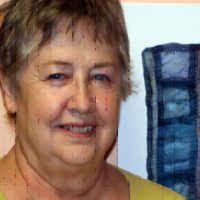

I am an artist. I’m aware I see things differently than others. Lines in nature have fascinated me from as early in my life as I can remember. Curves, lines, and shapes capture my attention. My eye follows grain patterns in wood, branches in trees, and wave impressions in the sand. I see shapes in nature that I mimic in simple ways in my work. Value shifts and color relationships intrigue and delight me.
I admire work of artists who are painters and sculptors. Often, I think of my work as painting with fabric. When I use sheer and translucent fabrics to merge one value with another, it results in subtle color gradations. I use hand and machine stitching as a mark-making tool, giving definition to positive and negative shapes, adding texture and the illusion of depth. I like to use large stitches with thick thread, using ancient symbols artists have selected since time immemorial as design elements.
These symbols convey meaning visually, without words, potentially having a unique meaning to each viewer. My vision, my art, comes from a non-verbal place in me. I work from my heart, rather than from my intellect.
I sense a dialogue with the work as I engage in this creative process. It becomes something of a separate entity as it begins to influence it’s own design elements and overall composition. Meaning emerges from this process. If my work communicates to another, I feel it is successful.
Since I create in a minimalist and abstract style, people compare my work to modern art paintings. The viewer is often surprised and delighted to recognize that fabric, paint, hand made paper and thread are the medium used to create my art. I paint sheer silk with an acrylic wash, or a fabric dye, and make designs on the fabric and hand made paper. I cut it up, create my composition, and then use thread to make marks, much like a drawing tool.
People will ask me, “Why not just paint? Why use fabric?” Textiles have an appeal to me for the tactile qualities not available in other mediums. Most people want to reach out and touch a work of fiber art, unlike their response to something like a painting.
The weave of fiber allows one to see how it is constructed, reminding me of construction features in rustic barns, or a fence. Rather than trim stray threads in the art, I keep them a part of the work to highlight the essence of fabric.
Fabric can be opaque, sheer, or translucent. It can be thick or thin. It can be rough, smooth, shiny or dull. It can be a solid, one color, or a gradation of one or many colors, or an incredibly complex design. It can have texture woven in, or be flat. It can feel cold, or warm. It can be fuzzy or slick.
Fabric is malleable, allowing one to scrunch it, pleat it, put holes in it, stretch it, burn it, layer it, dye it, paint it, stencil it, stitch it, among other surface design techniques.
Fabric from India is different from fabric from Japan, which is different from fabric from Africa, or fabric from the United Kingdom, or Australia, or from China, or from the Mekong Delta, or from the United States.
I love seeing the artist’s hand in fabrics from around the world. The more I experiment with fabrics of all kinds, the more possibilities I discover, and the more I learn. It’s a true lifelong adventure in personal growth.
Art making with fabric is a slow process. It’s meditative and restorative for me. Being a creator is a powerful activity that helps me maintain a healthy perspective about myself, my family, and our place in the world.
I’ve been a studio artist since 1995, exhibiting regionally, nationally and internationally. My work has been collected, published and exhibited around the world. The United States State Department, Art in Embassies Program has exhibited two of my pieces in Islamabad, Pakistan, and honored me by purchasing four large pieces for the new American Embassy in the Congo.
Since I retired from my profession as a clinical social worker, I am a studio artist. My art is an expression of my faith, joy of life, and inner peace that brings balance to my life.
Website
www.rosemaryclaus-gray.com
[smart-photo background_color=”#ffffff” height=”40em” text_color=”#666666″ title=”true” title_expanded=”true” thumbnails_position=”bottom” transition=”fade_moveFromRight” thumb_width=”70″ thumb_height=”70″ transition_rows=”1″ slideshow_can_random=”false” tooltips=”true”]
[/smart-photo]